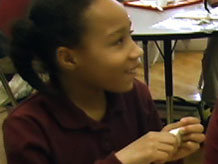What happens to weight and volume when we reshape a ball of clay?
2. Explore weight and volume

Distribute a tray of materials to each group. Ask volunteers to outline the steps to answer the investigation question. What data will they need to collect before and after changing the shape? What methods will they use? Write the steps on the board as students offer them, and then refine the sequence as necessary. In particular, explain the following two rules:
- Students must use all of the original material in the transformed shape; otherwise it is not a fair test.
- In order to check volume, students must be able to fit their new shape into the big cup and submerge it completely in the water; if they need to curl their shape to do this, that’s OK.
Give students a few minutes to record their predictions in their science notebooks [What happens to weight and volume when we reshape a ball of clay?], and then have them each transform a ball of plastic modeling clay into a shape — or a collection of shapes — of their own choosing.
Have students work through the procedure in pairs, everyone recording their own data in their notebooks as they go along. Students may try as many shapes as time allows.
As you circulate among the groups, ask students what they are thinking about how shape affects volume. If they are already certain that their new shape will not change the weight and volume of the plastic modeling clay, challenge them to try to find a shape that will.
A Likely Sequence of Investigation:
- Weigh the plastic modeling clay and record the weight in the notebook.
- Mark the starting water level in the big cup.
- Carefully lower the plastic modeling clay into the cup to determine how much water is displaced.
- Mark the new water level and record the information in your notebook.
- Remove the plastic modeling clay, dry it with a paper towel, and change its shape.
- Repeat the process with the new shape.
After students finish collecting and recording their data, have them record their claims in their notebooks and then share them within their small groups.



